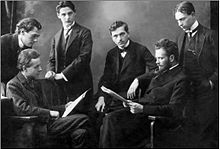Chamber music by Béla Bartók
Béla Bartók has created a diverse work of chamber music , the focus of which is on his six string quartets .
String quartets
String Quartet No. 1, Op. 7, Sz 40 (1908–1909)

- Lento - attacca:
- Poco a poco accelerando all'allegretto - Introduzione. Allegro - attacca:
- Allegro vivace
The quartet was premiered on March 19, 1910 in Budapest by the Waldbauer Quartet. Two days earlier there was a concert with works by Zoltán Kodály . Both events are referred to as the "double birthday of modern Hungarian music".
The first string quartet clearly shows Bartók's engagement with the music of late German Romanticism ( Wagner and Schönberg's Transfigured Night ) and the music of Debussy .
String Quartet No. 2, Op. 17, Sz 67 (1915–1917)
- Moderato
- Allegro molto capriccioso
- Lento
The second quartet was premiered on March 3, 1918 in Budapest by the Waldbauer Quartet.
String Quartet No. 3 Sz 85 (1927)
- Prima parte: Moderato - attacca:
- Seconda parte: Allegro - attacca:
- Ricapitulazione della prima parte: Moderato - attacca:
- Coda: Allegro molto
First performance on February 19, 1929 in London by the Waldbauer Quartet. The third quartet is Bartók's shortest and most concentrated string quartet.
String Quartet No. 4 Sz 91 (1928)
- Allegro
- Prestissimo, con sordino
- Non troppo lento
- Allegretto pizzicato
- Allegro molto
The fourth quartet was premiered on March 20, 1929 in Budapest by the Waldbauer Quartet. It is dedicated to the Pro Arte Quartet.
String Quartet No. 5 Sz 102 (1934)
- Allegro
- Adagio molto
- Scherzo. Alla bulgarese
- Andante
- Final. Allegro vivace
The fifth quartet is a commissioned composition for the patron Elizabeth Sprague Coolidge . It was premiered on April 8, 1935 in New York by the Kolisch Quartet .
String Quartet No. 6 Sz 114 (1939)
- Mesto - Piu mosso, pesante - Vivace
- Mesto - Marcia
- Mesto - Burletta
- Mesto
The sixth quartet is the last work Bartók completed in Europe before emigrating. First performance on January 20, 1941 in New York by the Kolisch Quartet, to which the quartet is also dedicated; 1946 European premiere in Budapest by the Waldbauer Quartet.
Works for violin and piano
Sonata for violin and piano No. 1, Sz 75 (1921)
- Allegro appassionato
- adagio
- Allegro
First performance on February 8, 1922 in Vienna by the violinist Mary Dickenson-Auner and the pianist Eduard Steuermann .
Sonata for Violin and Piano No. 2 Sz 76 (1922)
- Molto moderato
- Allegretto
Rhapsody for violin and piano No. 1, Sz 86 (1928)
- Moderato - attacca:
- Allegretto
Rhapsody for violin and piano No. 2, Sz 89 (1928)
- Moderato
- Allegro moderato
Works for violin
44 Duos for two violins, Sz 98 (1931)
The 44 duos were created for a violin school work edited by the music teacher Erich Doflein .
Sonata for violin alone, Sz 117 (1944)
- Tempo di ciaconna
- Fugue
- Melody
- Presto
The solo violin sonata was commissioned for the violinist Yehudi Menuhin . It is Bartók's last work of chamber music. The sonata was premiered on November 26, 1944 in New York by Menuhin.
Other chamber music works
Piano quintet (1904)
The little-known piano quintet is a late Romantic early work by Bartók. It was premiered on November 21, 1904 in Vienna by Bartók and the Prill Quartet.
Sonata for two pianos and percussion, Sz 110 (1937)
- Assai lento - Allegro molto
- Lento, ma non troppo
- Allegro non troppo
The sonata was commissioned for Paul Sacher . It was premiered on January 16, 1938 in Basel by Bartók, his wife Ditta and the drummers Fritz Schiesser and Phillip Rühlig.
Contrasts for violin, clarinet and piano, Sz 111 (1938)
- Verbunkos: Moderato ben ritmico
- Pihenő: Lento
- Sebes: Allegro vivace
The contrasts are a commissioned composition for the violinist Joseph Szigeti and the clarinetist Benny Goodman . The first performance of the complete work took place (with Bartok as pianist) on April 21, 1940 in New York. There is a recording of this cast.